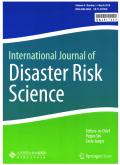Assessing Global Landslide Casualty Risk Under Moderate Climate Change Based on Multiple GCM Projections
IF 4
2区 地球科学
Q2 GEOSCIENCES, MULTIDISCIPLINARY
引用次数: 0
Abstract
Abstract Extreme precipitation-induced landslide events are projected to increase under climate change, which poses a serious threat to human lives and property. In this study, a global-scale landslide risk assessment model was established using global landslide data, by considering landslide hazard, exposure, and vulnerability. The global climate model data were then employed to drive the established global landslide risk model to explore the spatial and temporal variations in future landslide risk across the globe as a result of extreme precipitation changes. The results show that compared to the 30-year period from 1971 to 2000, the average annual frequency of landslides triggered by extreme precipitation is projected to increase by 7% and 10%, respectively, in the future 30-year periods of 2031–2060 and 2066–2095. The global average annual casualty risk of landslides is projected to increase from about 3240 to 7670 and 8380, respectively (with growth rates of 140% and 160%), during the 2031–2060 and 2066–2095 periods under the SSP2-4.5 scenario. The top 10 countries with the highest casualty risk of landslides are China, Afghanistan, India, the Philippines, Indonesia, Rwanda, Turkey, Nepal, Guatemala, and Brazil, 60% of which are located in Asia. The frequency and intensity of extreme precipitation will increase under climate change, which will lead to an increase in casualties from landslides in mountainous areas globally, and this risk should be taken seriously. The present study was an attempt to investigate and quantify the impact of global landslide casualty risk under climate change, which still has uncertainty in terms of outcomes, and there remains a need for further understanding in the future of the propagation of uncertainty between the factors that affect the risk.基于多重GCM预估的温和气候变化下全球滑坡灾害风险评估
在气候变化的背景下,极端降水诱发的滑坡事件预计会增加,对人类生命财产造成严重威胁。本文利用全球滑坡数据,综合考虑滑坡危险性、暴露性和脆弱性,建立了全球滑坡风险评估模型。利用全球气候模式数据驱动建立的全球滑坡风险模型,探讨极端降水变化对未来全球滑坡风险的时空变化影响。结果表明,与1971 ~ 2000年30年相比,2031 ~ 2060年和2066 ~ 2095年极端降水诱发滑坡的年平均频率分别增加7%和10%。在SSP2-4.5情景下,预计在2031-2060年和2066-2095年期间,全球平均每年因滑坡造成的伤亡风险将分别由约3240人增加至7670人和8380人(增长率分别为140%和160%)。山体滑坡造成人员伤亡风险最高的10个国家是中国、阿富汗、印度、菲律宾、印度尼西亚、卢旺达、土耳其、尼泊尔、危地马拉和巴西,其中60%位于亚洲。在气候变化的影响下,极端降水发生的频率和强度都将增加,这将导致全球山区山体滑坡造成的人员伤亡增加,这一风险应引起高度重视。本研究试图对气候变化下全球滑坡灾害风险的影响进行调查和量化,气候变化在结果方面仍存在不确定性,未来还需要进一步了解影响风险的因素之间的不确定性传播。
本文章由计算机程序翻译,如有差异,请以英文原文为准。
求助全文
约1分钟内获得全文
求助全文
来源期刊

International Journal of Disaster Risk Science
GEOSCIENCES, MULTIDISCIPLINARYMETEOROLOGY-METEOROLOGY & ATMOSPHERIC SCIENCES
CiteScore
6.50
自引率
7.50%
发文量
63
审稿时长
13 weeks
期刊介绍:
The International Journal of Disaster Risk Science (IJDRS) provides a pioneering platform for researchers and practitioners aiming at greater resilience and integrated risk governance in view of local, regional, and global disasters. IJDRS breaks new ground in research about disaster risks by connecting in-depth studies of actual disasters and of specific practices of disaster risk management with investigations of the global dynamics of disaster risks and theories and models relevant for advanced integrated risk governance.
 求助内容:
求助内容: 应助结果提醒方式:
应助结果提醒方式:


